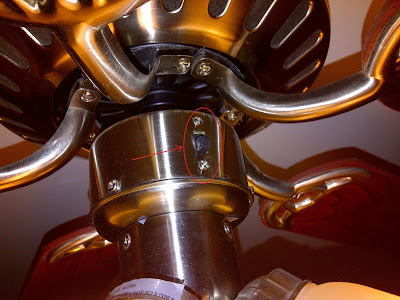Ceiling Fan Direction- Set your Ceiling Fan to Rotate in the Right Direction
 |
| Most Ceiling Fans are Reversible for Summer and Winter Image Source: Dr. Penny Pincher |
The cost to operate a ceiling fan is much lower than the cost to operate an air conditioner or furnace. Using a ceiling fan properly can keep you comfortable at a higher thermostat setting in the summer or at a cooler thermostat setting in the winter, saving you money on heating and cooling costs.
It is not obvious by looking to determine the correct direction for a ceiling fan to rotate in summer and in winter. I think it would be useful if the switch to reverse direction was somehow labeled to indicate the summer position and the winter position, but I have never seen one labeled. Which way should your ceiling fan rotate?
Which direction should your ceiling fan rotate in summer and winter?
Summer Ceiling Fan Direction
In summer, a ceiling fan should rotate counterclockwise when viewed from below. The fan should turn so that the up-turned edge of the blade is leading. This results in air being pushed down directly under the fan. This ceiling fan direction provides the most cooling effect from moving air.Winter Ceiling Fan Direction
In winter, the ceiling fan should turn clockwise when viewed from underneath so that downward turned edge of the fan blade is leading. This results in air being pulled up toward the ceiling fan. This will mix cooler air from near the floor with warmer air near the ceiling and circulate it throughout your living space.Wrong Ceiling Fan Direction
Even if your ceiling fan is turning the wrong direction, you can still get some climate control benefit. In winter, if your ceiling fan is turning in the summer direction, it will still circulate air and help move the warm air near the ceiling down to where you will feel it. The downside is that you will feel the moving air from the ceiling fan and this may make you feel cooler. In summer, if your ceiling fan is turning in the wrong direction you will not get the windchill effect under the fan, but moving air will help somewhat with cooling especially near the walls in the room where the ceiling fan is located.How to reverse the rotation of your ceiling fan
Switch in Plain Sight
Most, but not all ceiling fans are reversible. If your ceiling fan is reversible the most likely way to control the rotation direction is a switch on the outside of the fan. The picture below shows the most common style and location of switch to reverse the ceiling fan direction. Many switches are not labeled, but a switch like this on a ceiling fan is likely to control the blade direction. | |
|
Where to find the Hidden Ceiling Fan Switch
How do you reverse the direction of your ceiling fan if there is no switch? In some ceiling fans, the switch to change the direction of rotation is located on top of the fan. This can be confusing- there are lots of questions posted on the internet by people looking for the reverse switch on their ceiling fan. If you can’t see it standing under your ceiling fan, you may need to stand on a chair or use a ladder to locate the switch on top. The picture below shows a rotation direction switch on top of a ceiling fan. There is no way to see this switch when standing below the fan. The model shown is a Harbor Breeze Wakefield. Other models have reverse switches on top as well. |
| No reverse direction switch is visible on this ceiling fan- how do you reverse the direction? Image Source: Dr. Penny Pincher |
 |
| The reverse direction switch is hidden on top! Image Source: Dr. Penny Pincher |
Remote Control
Another way to change the rotation direction of a ceiling fan is using the remote control. If your ceiling fan has a remote control, there may be a combination of buttons on the remote that can be pressed to reverse the fan direction. If this is not labeled on your remote control, you will need to search for a manual to determine the correct buttons to change the fan direction using the remote control. It may be easier to use the switch on the fan itself rather than using the remote control.
Recommended Reading
Copyright © 2013 Dr. Penny Pincher. All Rights Reserved. Privacy Policy
No comments:
Post a Comment